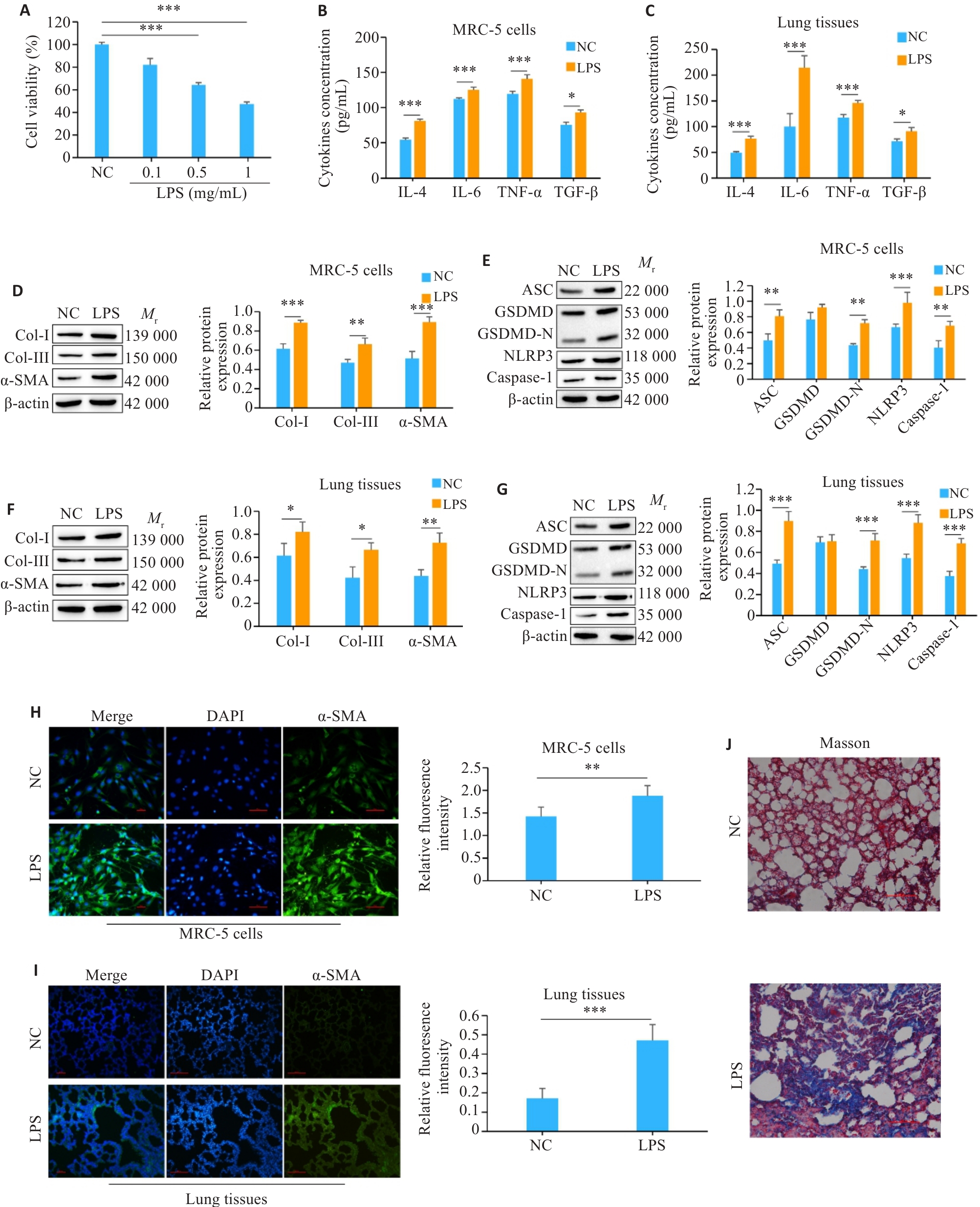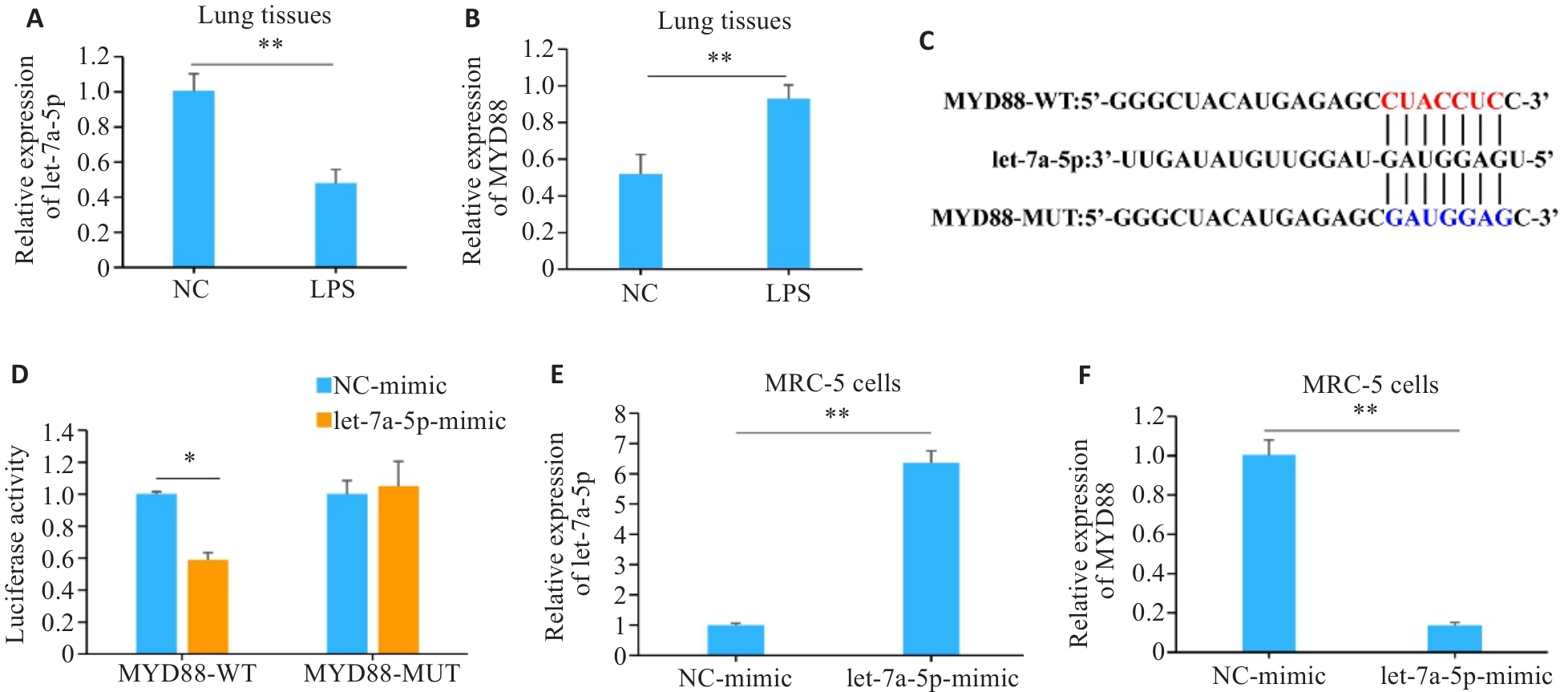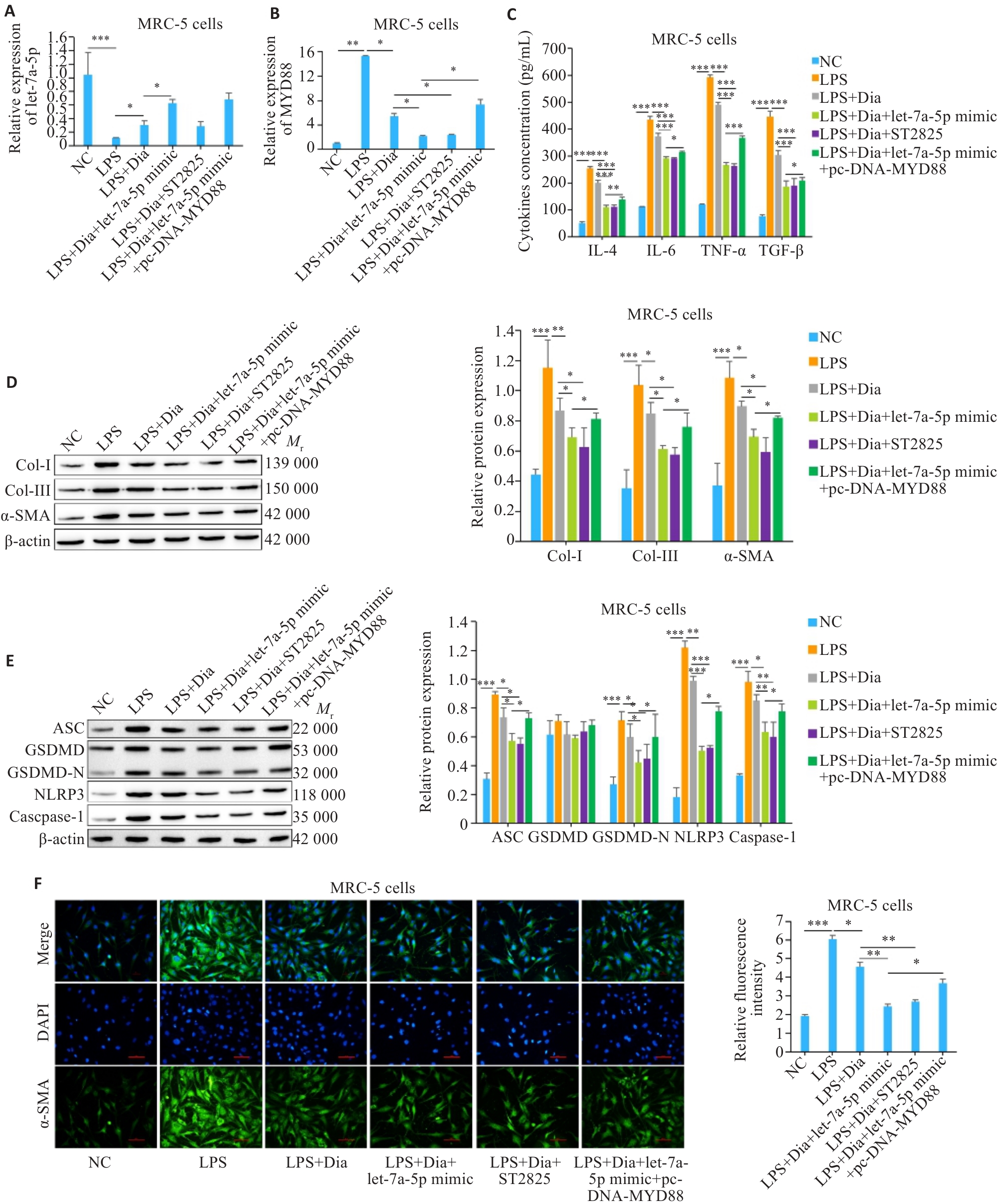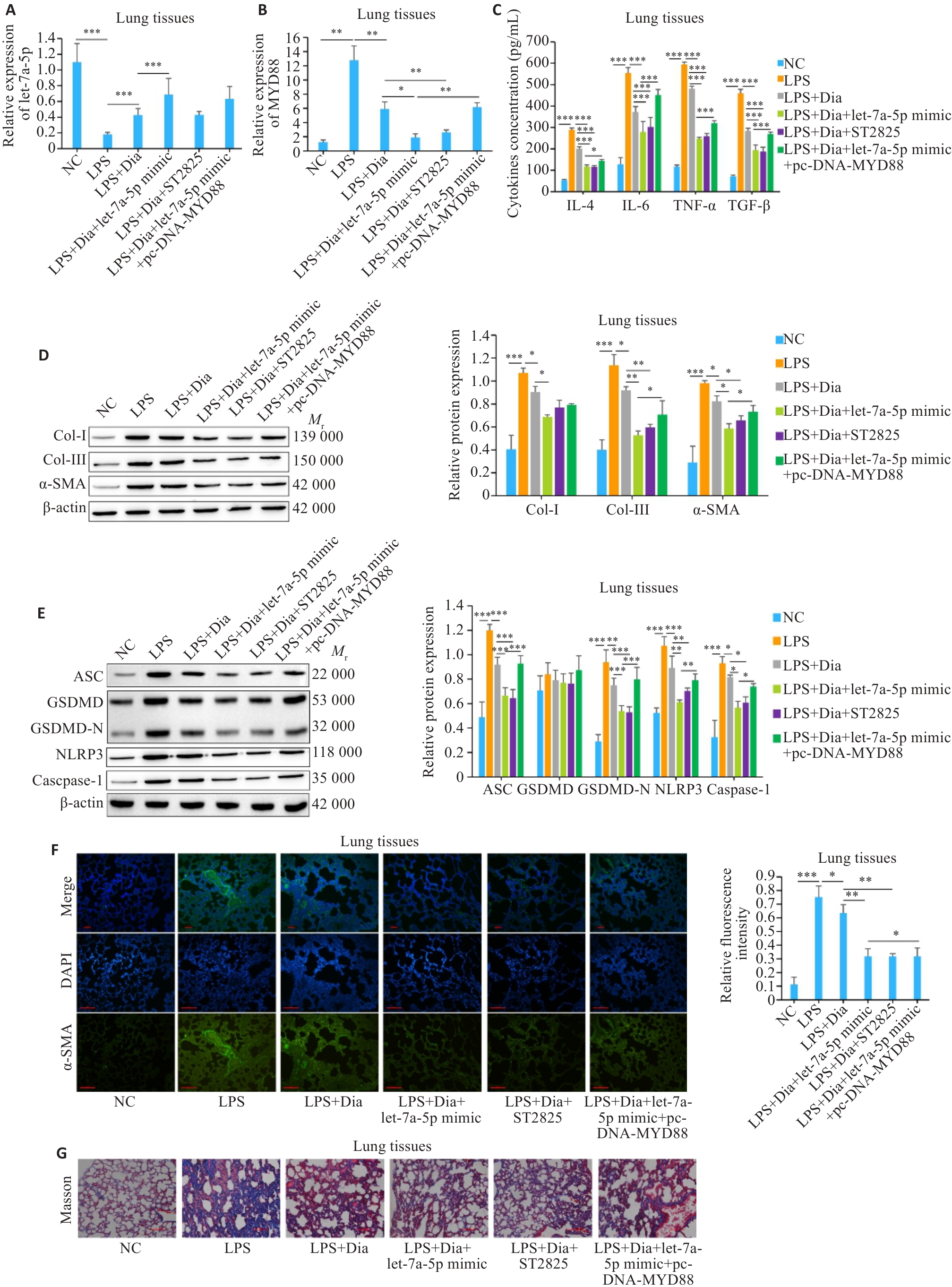Journal of Southern Medical University ›› 2024, Vol. 44 ›› Issue (11): 2092-2101.doi: 10.12122/j.issn.1673-4254.2024.11.05
Duanyi SONG( ), Yun LI, Xuefang TANG, Hua LI, Kang TAO
), Yun LI, Xuefang TANG, Hua LI, Kang TAO
Received:2024-02-08
Online:2024-11-20
Published:2024-11-29
Contact:
Duanyi SONG
E-mail:songduanyi1@163.com
Duanyi SONG, Yun LI, Xuefang TANG, Hua LI, Kang TAO. Diazepam alleviates pulmonary fibrosis in mice by inhibiting LPS-induced pyroptosis and inflammation via the let-7a-5p/MYD88 axis[J]. Journal of Southern Medical University, 2024, 44(11): 2092-2101.
Add to citation manager EndNote|Ris|BibTeX
URL: https://www.j-smu.com/EN/10.12122/j.issn.1673-4254.2024.11.05
| Target | Sequence |
|---|---|
| let-7a-5p | F: 5'-TGAGGTAGTAGGTTGTATAGTT-3' |
| R: 5'-AGTGCAGGGTCCGAGGTATT-3' | |
| MYD88 | F: 5'-GGCTGCTCTCAACATGCGA-3' |
| R: 5'-CTGTGTCCGCACGTTCAAGA-3' | |
| U6 | F: 5'-CTCGCTTCGGCAGCACA-3' |
| R: 5'-AACGCTTCACGAATTTGCGT-3' | |
| GAPDH | F: 5'-GAAGGTGAAGGTCGGAGTC-3' |
| R: 5'-GAAGATGGTGATGGGATTTC-3' |
Tab.1 Sequences of primers for RT-qPCR
| Target | Sequence |
|---|---|
| let-7a-5p | F: 5'-TGAGGTAGTAGGTTGTATAGTT-3' |
| R: 5'-AGTGCAGGGTCCGAGGTATT-3' | |
| MYD88 | F: 5'-GGCTGCTCTCAACATGCGA-3' |
| R: 5'-CTGTGTCCGCACGTTCAAGA-3' | |
| U6 | F: 5'-CTCGCTTCGGCAGCACA-3' |
| R: 5'-AACGCTTCACGAATTTGCGT-3' | |
| GAPDH | F: 5'-GAAGGTGAAGGTCGGAGTC-3' |
| R: 5'-GAAGATGGTGATGGGATTTC-3' |

Fig.1 LPS induces pyroptosis and inflammation and causes pulmonary fibrosis. A: Effects of different concentrations of LPS on proliferation of MRC-5 cells. B: Detection of the levels of inflammation-related factors in MRC-5 cells by ELISA. C: Detection of the levels of inflammatory factors in mouse lung tissues by ELISA. D, E: Detection of the expressions of fibrosis- and pyroptosis-related proteins in MRC-5 cells by Western blotting. F, G: Detection of the expressions of fibrosis- and pyroptosis-related proteins in mouse lung tissues by Western blotting. H, I: Immunofluorescence staining of α-SMA in MRC-5 cells and mouse lung tissues (Scale bar=100 μm). J: Masson staining of mouse lung tissues (Scale bar=100 μm). *P<0.05, **P<0.01, ***P<0.001.

Fig.2 Verification of expressions of let-7a-5p and MYD88 in mouse lung tissues and their targeting relationship. A: Detection of let-7a-5p expression in lung tissues by RT-qPCR. B: Detection of MYD88 expression in mouse lung tissues by RT-qPCR. C: Target-binding sequences of let-7a- 5p and MYD88. D: Verification of the targeting relationship between let-7a-5p and MYD88 by dual-luciferase assay. E: Confirmation of the transfection efficiency of let-7a-5p mimic. F: Detection of the expression of MYD88 by RT-qPCR. *P<0.05, **P<0.01.

Fig.4 Diazepam inhibits LPS-induced pyroptosis and inflammatory response in MRC-5 cells through the let-7a-5p/MYD88 axis. A: Expression of let-7a-5p in MRC-5 cells. B: Expression of MYD88 in MRC-5 cells. C: Levels of inflammatory factors in MRC-5 cells detected by ELISA. D: Expressions of fibrosis-related proteins in MRC-5 cells detected by Western blotting. E: Expressions of pyroptosis-related proteins in MRC-5 cells detected by Western blotting. F: Immunofluorescence staining of α-SMA in MRC-5 cells (Scale bar=100 μm).*P<0.05, **P<0.01, ***P<0.001.

Fig.5 Diazepam inhibits LPS-induced pyroptosis and inflammatory response and alleviates pulmonary fibrosis in mice through the let-7a-5p/MYD88 axis. A, B: Expression of let-7a-5p and MYD88 in mouse lung tissues. C: Levels of inflammatory factors in mouse lung tissues detected by ELISA. D, E: Expressions of fibrosis- and pyroptosis-related proteins in mouse lung tissues detected by Western blotting. F: Immunofluorescence staining of α-SMA in mouse lung tissues (Scale bar=100 μm). G: Masson staining of mouse lung tissues (Scale bar=100 μm).*P<0.05, **P<0.01, ***P<0.001.
| 1 | Kishaba T. Evaluation and management of Idiopathic Pulmonary Fibrosis[J]. Respir Investig, 2019, 57(4): 300-11. |
| 2 | Shi J, Zhou LR, Wang XS, et al. KLF2 attenuates bleomycin-induced pulmonary fibrosis and inflammation with regulation of AP-1[J]. Biochem Biophys Res Commun, 2018, 495(1): 20-6. |
| 3 | Suzuki T, Tada, Gladson S, et al. Vildagliptin ameliorates pulmonary fibrosis in lipopolysaccharide-induced lung injury by inhibiting endothelial-to-mesenchymal transition[J]. Respir Res, 2017, 18(1): 177. |
| 4 | Zhou Y, Li P, Duan JX, et al. Aucubin alleviates bleomycin-induced pulmonary fibrosis in a mouse model[J]. Inflammation, 2017, 40(6): 2062-73. |
| 5 | Cesta MF, Ryman-Rasmussen JP, Wallace DG, et al. Bacterial lipopolysaccharide enhances PDGF signaling and pulmonary fibrosis in rats exposed to carbon nanotubes[J]. Am J Respir Cell Mol Biol, 2010, 43(2): 142-51. |
| 6 | Wang DS, Zurek AA, Lecker I, et al. Memory deficits induced by inflammation are regulated by α5-subunit-containing GABAA receptors[J]. Cell Rep, 2012, 2(3): 488-96. |
| 7 | Yocum GT, Turner DL, Danielsson J, et al. GABAA receptor α4-subunit knockout enhances lung inflammation and airway reactivity in a murine asthma model[J]. Am J Physiol Lung Cell Mol Physiol, 2017, 313(2): L406-15. |
| 8 | Cui JJ, Zhou ZQ, Yang HY, et al. MST1 suppresses pancreatic cancer progression via ROS-induced pyroptosis[J]. Mol Cancer Res, 2019, 17(6): 1316-25. |
| 9 | Lee S, Suh GY, Ryter SW, et al. Regulation and function of the nucleotide binding domain leucine-rich repeat-containing receptor, pyrin domain-containing-3 inflammasome in lung disease[J]. Am J Respir Cell Mol Biol, 2016, 54(2): 151-60. |
| 10 | Panganiban RA, Sun MY, Dahlin A, et al. A functional splice variant associated with decreased asthma risk abolishes the ability of gasdermin B to induce epithelial cell pyroptosis[J]. J Allergy Clin Immunol, 2018, 142(5): 1469-78. e2. |
| 11 | He DK, Chen JF, Shao YR, et al. Adenovirus-delivered angiopoietin-1 ameliorates phosgene-induced acute lung injury via inhibition of NLRP3 inflammasome activation[J]. Inhal Toxicol, 2018, 30(4/5): 187-94. |
| 12 | Hou L, Yang ZW, Wang ZK, et al. NLRP3/ASC-mediated alveolar macrophage pyroptosis enhances HMGB1 secretion in acute lung injury induced by cardiopulmonary bypass[J]. Lab Invest, 2018, 98(8): 1052-64. |
| 13 | Xu WJ, Wang XX, Jin JJ, et al. Inhibition of GGPPS1 attenuated LPS-induced acute lung injury and was associated with NLRP3 inflammasome suppression[J]. Am J Physiol Lung Cell Mol Physiol, 2019, 316(3): L567-L577. |
| 14 | Li ZY, Jia YF, Feng Y, et al. Methane alleviates sepsis-induced injury by inhibiting pyroptosis and apoptosis: in vivo and in vitro experiments[J]. Aging, 2019, 11(4): 1226-39. |
| 15 | Liu L, Sun BW. Neutrophil pyroptosis: new perspectives on sepsis[J]. Cell Mol Life Sci, 2019, 76(11): 2031-42. |
| 16 | Yokoyama S, Cai Y, Murata M, et al. A novel pathway of LPS uptake through syndecan-1 leading to pyroptotic cell death[J]. Elife, 2018, 7: e37854. |
| 17 | O’Brien J, Hayder H, Zayed Y, et al. Overview of microRNA biogenesis, mechanisms of actions, and circulation[J]. Front Endocrinol, 2018, 9: 402. |
| 18 | Ma YX, Shen N, Wicha MS, et al. The roles of the let-7 family of microRNAs in the regulation of cancer stemness[J]. Cells, 2021, 10(9): 2415. |
| 19 | Duan SY, Li JX, Tian JQ, et al. Crosstalk between let-7a-5p and BCL-xL in the Initiation of Toxic Autophagy in Lung Cancer[J]. Mol Ther Oncolytics, 2019, 15: 69-78. |
| 20 | Chen SY, Chen YL, Li PC, et al. Engineered extracellular vesicles carrying let-7a-5p for alleviating inflammation in acute lung injury[J]. J Biomed Sci, 2024, 31(1): 30. |
| 21 | Deguine J, Barton GM. MyD88: a central player in innate immune signaling[J]. F1000Prime Rep, 2014, 6: 97. |
| 22 | Oda K, Kitano H. A comprehensive map of the toll-like receptor signaling network[J]. Mol Syst Biol, 2006, 2: 2006.0015. |
| 23 | Akira S. Toll-like receptor signaling[J]. J Biol Chem, 2003, 278(40): 38105-8. |
| 24 | Li Y, Song DY, Bo FY, et al. Diazepam inhibited lipopolysaccharide (LPS)‑induced pyroptotic cell death and alleviated pulmonary fibrosis in mice by specifically activating GABAA receptor α4-subunit[J]. Biomed Pharmacother, 2019, 118: 109239. |
| 25 | Gu NN, Xing SP, Chen SH, et al. Lipopolysaccharide induced the proliferation of mouse lung fibroblasts by suppressing FoxO3a/p27 pathway[J]. Cell Biol Int, 2018, 42(10): 1311-20. |
| 26 | Dong ZW, Yuan YF. Juglanin suppresses fibrosis and inflammation response caused by LPS in acute lung injury[J]. Int J Mol Med, 2018, 41(6): 3353-65. |
| 27 | de Lima CB, Sakai M, Latorre AO, et al. Effects of different doses and schedules of diazepam treatment on lymphocyte parameters in rats[J]. Int Immunopharmacol, 2010, 10(11): 1335-43. |
| 28 | Nicolás FH, Cristian F, Lucía R, et al. Diazepam effects on immune cells actively involved during the development of experimental autoimmune encephalomyelitis[J]. Front Immunol, 2015, 6: 224. |
| 29 | Fernández Hurst N, Zanetti SR, Báez NS, et al. Diazepam treatment reduces inflammatory cells and mediators in the central nervous system of rats with experimental autoimmune encephalomyelitis[J]. J Neuroimmunol, 2017, 313: 145-51. |
| 30 | Sanders RD, Grover V, Goulding J, et al. Immune cell expression of GABAA receptors and the effects of diazepam on influenza infection[J]. J Neuroimmunol, 2015, 282: 97-103. |
| 31 | Huang Y, Xu W, Zhou RB. NLRP3 inflammasome activation and cell death[J]. Cell Mol Immunol, 2021, 18(9): 2114-27. |
| 32 | Song C, He LJ, Zhang J, et al. Fluorofenidone attenuates pulmonary inflammation and fibrosis via inhibiting the activation of NALP3 inflammasome and IL-1β/IL-1R1/MyD88/NF‑κB pathway[J]. J Cell Mol Med, 2016, 20(11): 2064-77. |
| 33 | Wang T, Zhu H, Yang SF, et al. Let-7a-5p may participate in the pathogenesis of diabetic nephropathy through targeting HMGA2[J]. Mol Med Rep, 2019, 19(5): 4229-37. |
| 34 | Zhang L, Hao CF, Zhai RN, et al. Downregulation of exosomal let-7a-5p in dust exposed-workers contributes to lung cancer development[J]. Respir Res, 2018, 19(1): 235. |
| 35 | Di Padova F, Quesniaux VFJ, Ryffel B. MyD88 as a therapeutic target for inflammatory lung diseases[J]. Expert Opin Ther Targets, 2018, 22(5): 401-8. |
| 36 | Liu L, Zhou L, Wang LL, et al. MUC1 attenuates neutrophilic airway inflammation in asthma by reducing NLRP3 inflammasome-mediated pyroptosis through the inhibition of the TLR4/MyD88/NF-κB pathway[J]. Respir Res, 2023, 24(1): 255. |
| 37 | Li CC, Yu Y, Li WJ, et al. Phycocyanin attenuates pulmonary fibrosis via the TLR2-MyD88-NF‑κB signaling pathway[J]. Sci Rep, 2017, 7(1): 5843. |
| [1] | Yiming SUN, Rong ZHANG, Ying MENG, Lei ZHU, Mingqiang LI, Zhe LIU. Coenzyme Q10 alleviates depression-like behaviors in mice with chronic restraint stress by down-regulating the pyroptosis signaling pathway [J]. Journal of Southern Medical University, 2024, 44(5): 810-817. |
| [2] | HE Cheng, CHEN Wei, ZHANG Nianzhi, LUAN Jun, WANG Sanfeng, ZHANG You. Shenqi Chongcao Formula ameliorates inflammatory response in rats with pulmonary fibrosis by activating the ASS1/src/STAT3 signaling pathway [J]. Journal of Southern Medical University, 2024, 44(4): 644-651. |
| [3] | FANG Shangping, SUN Renke, SU Hui, ZHAI Kecheng, XIANG Yu, GAO Yangmengna, GUO Wenjun. Chlorogenic acid alleviates acute kidney injury in septic mice by inhibiting NLRP3 inflammasomes and the caspase-1 canonical pyroptosis pathway [J]. Journal of Southern Medical University, 2024, 44(2): 317-323. |
| [4] | Ping SHU, Mengke YUAN, Ke YANG, Weizhi HE, Li LIU. Quercetin suppresses pyroptosis in mouse fibroblasts by inhibiting the NLRP3/caspase-1/GSDMD pathway [J]. Journal of Southern Medical University, 2024, 44(10): 1874-1880. |
| [5] | KONG Xiang, ZHANG Teng, ZHANG Yan, GAO Linxi, WANG Wen, WANG Mengyan, WANG Guodong, LÜ Kun. Overexpression of lncRNA HEM2M alleviates liver injury in mice with non-alcoholic fatty liver disease [J]. Journal of Southern Medical University, 2024, 44(1): 1-8. |
| [6] | LIANG Zichen, YU Changhui, LIANG Shixiu, ZHOU Zicong, ZHOU Zili, MENG Xiaojing, ZOU Fei, CAI Shaoxi. Platycodin D improves pulmonary fibrosis in mice by down-regulating TRPC6 expression and reducing ROS production in lung fibroblasts [J]. Journal of Southern Medical University, 2024, 44(1): 60-69. |
| [7] | WU Di, WANG Xiaole, GAO Yating, TONG Jiabing, YANG Qinjun, DING Huanzhang, ZHANG Lu, LI Zegeng. Shenqi Wenfei Formula alleviates chronic obstructive pulmonary disease in rats with pulmonary qi deficiency syndrome by regulating NLRP3/GSDMD pyroptosis pathway [J]. Journal of Southern Medical University, 2023, 43(9): 1500-1508. |
| [8] | LI Hongtao, DENG Yu, WANG Tianle, HUANG Keyong, YU Chuanpei, CHEN Chaojun. Danshenxinkun B protects human umbilical vein endothelial cells against ox-LDL-induced injury by inhibiting pyroptosis and the NF-κB/NLRP3 pathway [J]. Journal of Southern Medical University, 2023, 43(8): 1425-1431. |
| [9] | ZHANG Meng, ZHANG Yuanyuan, NIU Mengzhu, ZHU Yue, TONG Shiyi, KOU Xianjuan. Dihydromyricetin alleviates pyroptosis and necroptosis in mice with MPTP-induced chronic Parkinson's disease by inducing autophagy [J]. Journal of Southern Medical University, 2023, 43(8): 1268-1278. |
| [10] | LI Peipei, HU Yinqi, LIU Jia, WANG Lina, WU Yuanjie, HU Jianpeng. Naoluo Xintong Decoction activates caspase-1/Gasdermin D pathway to promote angiogenesis of rat brain microvascular endothelial cells after oxygen glucose deprivation/reperfusion injury [J]. Journal of Southern Medical University, 2023, 43(7): 1093-1101. |
| [11] | JIANG Yong, GE Wenting, ZHAO Ying, WU Yuge, HUO Yiming, PAN Lanting, CAO Shuang. LINC00926 promotes pyroptosis of hypoxia-induced human umbilical vein vascular endothelial cells by recruiting ELAVL1 [J]. Journal of Southern Medical University, 2023, 43(5): 807-814. |
| [12] | XIONG Fengmei, LIU Ruiping, LI Yang, SUN Na. Honokiol reduces doxorubicin-induced cardiotoxicity in vitro by inhibiting pyroptosis via activating AMPK/Nrf2 signaling [J]. Journal of Southern Medical University, 2022, 42(8): 1205-1211. |
| [13] | WANG Lulin, WANG Yuan, LIU Jian, HUANG Chuanbing, ZHANG Wandong, WAN Lei, SUN Yue, HUANG Dan. Effects of serum from Xinfeng capsule-treated rats on lipopolysaccharide-induced pyroptosis in rheumatoid arthritis synovial fibroblasts [J]. Journal of Southern Medical University, 2022, 42(12): 1846-1851. |
| [14] | FANG Shangping, YUAN Ran, SUN Renke, MA Tongjun. Knockout of S1PR3 attenuates acute lung injury in mice by inhibiting the MAPK pathway [J]. Journal of Southern Medical University, 2022, 42(12): 1815-1821. |
| [15] | JIANG Weiyi, DENG Zilong, ZHAO Wanghong. NLRC4 plays a regulatory role in F. nucleatum-induced pyroptosis in macrophages [J]. Journal of Southern Medical University, 2022, 42(10): 1560-1565. |
| Viewed | ||||||
|
Full text |
|
|||||
|
Abstract |
|
|||||